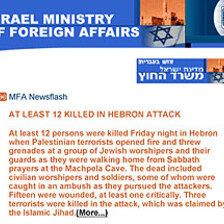The Electronic Intifada 19 November 2002
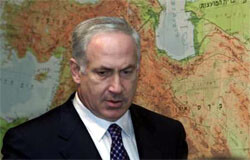
Above: “Israeli Foreign minister Binyamin Netanyahu prepares to speak with the press at his office in Jerusalem, November 16, 2002. Palestinian gunmen fired at Jewish settlers on their way to Sabbath eve prayers in the West Bank city of Hebron on Friday, killing at least 12 people and wounding 15 others. Netanyahu said he expected the world to ‘back any action that Israel decides to take against the Palestinian Authority and its leader Arafat in order to protect the lives of its citizens’. REUTERS/Nir Elias” [original Reuters caption]
On 15 November 2002, shooting rang out in the center of Hebron. Within minutes local residents began to pick up telephones and reports began to filter out to the world.
Shortly after, Yoni Peled, deputy spokesman of the Israeli Ministry of Foreign Affairs, had titled the attack the “Sabbath massacre” for the convenience of foreign journalists, and Israel’s distortion of the events began.
The earliest reports reflected the minimal information available while the events were still in progress but the tale was quickly spun.
CNN’s Breaking News e-mail arrived in the thick of the events and was brief, a product of its culling information from the breaking news on Israeli radio and television broadcasts: “Six killed after Palestinian gunmen open fire in Hebron, Israeli media report.”
A few minutes later, a similar electronic alert from MSNBC offered more detail, already incorporating the Israeli Ministry of Foreign Affairs’ story: “Palestinian gunmen fired at Jewish settlers on their way to Sabbath eve prayers in the West Bank city of Hebron Friday, killing at least six people and wounding an estimated 30 others, Israeli security sources said.”
And so it went. The wire services similarly and carelessly asserted an attack against “worshippers”.
The Associated Press reported:
“Palestinian militants opened fire on Jewish worshippers as they walked toward a disputed shrine after sundown Friday, killing at least 10 people and wounding 15 others, the Israeli military said.”Reuters reported:
“Palestinian gunmen ambushed Jewish settlers walking home from Sabbath prayers at the Tomb of the Patriarchs, killing at least 12 people in the deadliest attack on Israelis in Hebron in two years of violence.”As progressively more detailed reports were filed by foreign and local correspondents, and networks in the US and worldwide began to hear from their bureaus, most relied on this initial characterization of the events as an attack on a procession of “worshippers” and their “guards”.
The following day, 16 November 2002, the New York Times (NYT) reported that:
Twelve Israelis were killed here Friday night when Palestinian snipers ambushed Jewish settlers walking home from Sabbath prayers and then attacked the policemen, security guards and soldiers who rushed to the rescue, the Israeli Army said.Every news outlet that EI checked was echoing this narrative to some extent. All reports contained assertions that at least some of those killed were worshippers. Some reports suggested that most of those killed were worshippers — or that the attack was on the holy site itself (“Hebron gunmen kill 12 Israelis in attack on shrine”, London Times, 16 November 2002). Other reports added details about some of the victims being soldiers there to guard them/the settler rescue team.In a gunfight that raged for more than three hours as Israeli rescue workers struggled to evacuate the wounded from a dusty, exposed alley, the commander of Israeli forces in this divided city was one of those killed. Fifteen people were wounded, hospital officials said.
The New York Times’ article while reporting the basic Israeli narrative, maintained an appropriate but rare level of skepticism, noting:
“How many of the dead and wounded were civilians and how many were security forces was not clear early this morning.”Two other features on this site examine in detail NPR and CNN’s coverage of this attack.(“Israel Weighs Response After 12 Killed in Hebron Ambush”, New York Times, 16 November 2002).
What really happened
In reality, as reported in a special EI feature from 16 November 2002, Israel falsely claims “massacre” of “worshippers” in Hebron, the attackers waited until after all the settlers who had worshipped at the Tomb of the Patriarchs had returned home:
“The “all clear” had just sounded on the soldiers’ radios meaning worshipers had been safely escorted to their homes after Shabbat prayers in the Machpela Cave in downtown Hebron when shots rang out from an olive grove.”Ha’aretz website reported that:(“Murder on ‘Worshipers Way’ ” by Margot Dudkevitch, Jerusalem Post, 17 November 2002)
“According to an initial investigation by the army, in contrast to a version of events given by the foreign ministry, the Islamic Jihad fire was not directed at worshippers but at the security forces escorting them. All of the dead were from the IDF, Border Police or emergency security team of the settlers of Kiryat Arba and Hebron, who came to help evacuate the wounded.”The 12 Israelis killed in the attack were later identified as four Israeli soldiers, five “border police,” (weapons and military uniform are qualitatively indistinguishable from regular Israeli occupation troops), and three plain clothes members of a paramilitary security force operating from Kiryat Arba settlement, equipped with standard army jeeps and weapons.(“Hebron brigade commander among 12 killed in Jihad attack,” Ha’aretz (website), 16 November 2002)
Israeli media reports later confirmed that all 14 wounded were also armed combatants, including soldiers and settlers.
Why spin the news in this case?
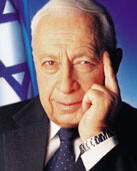
Israeli Prime Minister Ariel Sharon. (MFA)
Sharon has built his entire career on bloody violence against Palestinians and other Arabs. Responsible for notorious massacres — from Qibya in 1954 to Sabra and Shatila in Beirut in 1982 — Sharon is known as a man will stop at nothing to realize his objective of total and permanent Israeli control over all of “Greater Israel.”
Cast into the wilderness after an Israeli commission of inquiry found him “personally” if “indirectly” responsible for the war crimes in Sabra and Shatila refugee camps, Sharon’s political resurrection is merely a reflection of a deep-seated belief among many Israelis that the brutal repression, humiliation and dehumanization of the Palestinians will somehow bring them security — even when it is obvious to the international community that the opposite is true.
Sharon’s modus operandi during the Intifada has been to utilise brute force (heavy weapons such as F-16s, combat helicopters, tanks, and armoured bulldozers are now used daily) while simultaneously expanding Israel’s territory into the “easily explainable” areas around its existing geographic facts on the ground.
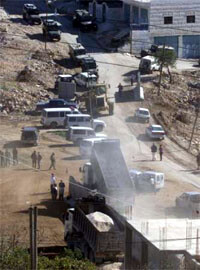
Above: “Jewish settlers escorted by the Israeli military erect a concrete barrier along the route used by settlers to walk to prayers inside the West Bank city of Hebron, November 18, 2002. Israel Radio quoted Israeli Prime Minister Sharon as saying during a visit with troops in the West Bank city that Israel should create ‘territorial continuity’ between Hebron and the adjacent Jewish settlement of Kiryat Arba. REUTERS/Nayef Hashlamoun” [original Reuters caption]
However, the endless nature of this perimeter expansion should act as a red flag to anyone following the details of the conflict. At what point does the repetative nature of this dynamic compel journalists to take a step back and look at the overall pattern? In an excellent background article published by the Village Voice in September 2001, journalist Alisa Solomon noted that in the first year of the Intifada alone (we are now in the third year), “one-fifth of [Gaza’s] crops have been flattened by the IDF since the conflict flared.”
The Palestinian Center for Human Rights reports that “Israeli occupation forces have razed approximately 16,000 dunums (a dunum is 1,000 square meters) of land in the Gaza Strip, most of it agricultural, during the al-Aqsa Intifada, or approximately 9 percent of the total arable land.”
On 6 March 2002, the Special Rapporteur of the UN Commission on Human Rights reported that:
“The creation of buffer zones for bypass roads and settlements has resulted in the “sweeping” of large areas of agricultural land by bulldozers. A total of 285,808 fruit and olive trees have been uprooted, and wells and agricultural constructions have been destroyed. Lasting harm has been done to the environment by these acts of destruction, designed to secure the comfort and security of illegal settlements.”Sharon has provoked and incited Palestinian violence against Israel at key points by increasing repression and the frequency of assassination operations against Palestinian leaders during periods where Palestinians groups have not been carrying out attacks. After ‘rattling the cage’ and provoking a Palestinian response, Sharon is then free to cast Israel’s land-razing and expropriation of Palestinian land around any targeted settlements and military bases as “self defense” or “retaliation,” a narrative that the international media have been all too ready to accept.
The most infamous example of this dynamic was Israel’s presentation of its hugely destructive March/April 2002 invasion as “retaliation” for an attack against Israelis enjoying a Passover dinner. Operation “Defensive Shield” was subsequently presented as a response to this attack, although the planned operation had already been discussed in the media for an entire week.
It didn’t take Israel long to use the “Shabbat massacre” to justify further expansion of its military occupation in Hebron. Ha’aretz reported on 17 November 2002 that Foreign Minister Benjamin Netanyahu, a master of media manipulation, arguing that the Hebron attack meant that there should be “a shift from a policy of attrition to one of wiping out terror commands and establishing security buffer zones.”
By seizing “opportunities” like the Hebron attack, Israel has — like all colonial powers — managed to cloak naked land-grabs in the language of “security.” To uncover this pattern is time-consuming and beyond the scope of most journalists and human rights or activist organizations with limited resources. When we can find time to do it, what our research turns up is often spectacular and instructive, as in the case of EI’s study of 50 days of Israeli actions on the ground during a declared “unilateral ceasefire” in May-July 2001. As such it remains a hard issue to raise in this soundbite-obsessed media.
The practice of using the pretext of “security” to seize land for buffer zones and settler roads, and ultimately more settlement, was a key feature of the Oslo process, during which the number of Israeli settlers in the Occupied Territories doubled.
“Everybody has to move, run and grab as many hilltops as they can to enlarge the settlements because everything we take now will stay ours… Everything we don’t grab will go to them,” exhorted then Foreign Minister Ariel Sharon at a 15 November 1998 meeting of the extreme right Tsomet Party (Agence France Presse).
And this is exactly what happened in the wake of the 15 November 2002 attack in Hebron.
The aftermath: creating a rationale for ethnic cleansing
While UN Secretary General Kofi Annan, US Secretary of State Colin Powell, and diplomats around the world — misled by the fabrications put out by the Israeli Ministry of Foreign Affairs — rushed to offer condolences for the “shocking and reprehensible” and “despicable terrorist attack” on “Jewish worshipers”, Sharon and his allies in Hebron were planning the next seizure of Palestinian land.
The day after the attack, as Israeli tanks rolled into Hebron and bulldozed homes along the route between Kiryat Arba and the Ibrahimi Mosque/Tomb of the Patriarchs, Jerusalem Post headlines declared, “Settlers announce establishment of outpost on site of Hebron attack”.
The Guardian reported that:
After the residents of Kiryat Arba buried three of their security guards killed on Friday, they placed three shipping containers close to the scene of the shooting to create an outpost. One of the containers was spray painted with the message: “Death to Arabs”.Sharon wasted no time in rubber stamping the fledgling settlement. Ha’aretz reported that:Jonathan Stern, 19, a resident of Kiryat Arba, said the houses and trees where the attackers hid would be removed. “This whole area will be cleared in a couple of weeks. We will only live in peace when the Palestinians are expelled from here. The government will realise this when they have exhausted every other option.”
Natan Sharansky, the Israeli housing minister urged the prime minster to link the settlements: “We have to build settlement contiguity between Kiryat Arba, the Cave of the Patriarchs and the settlement community in Hebron.”
(“Sharon threatens to expand Hebron enclave” by Conal Urquhart, Guardian, 18 November 2002)
“Prime Minister Ariel Sharon told IDF commanders in Hebron on Sunday that the opportunity that now presents itself in the wake of the attack Friday evening in the city, in which 12 Israelis were killed, must be exploited to establish new facts on the ground. Israel Radio reported that Sharon said that territorial continuity between the settlement of Kiryat Arba and the Jewish section of Hebron, including the Tomb of the Patriarchs, must be ensured.”
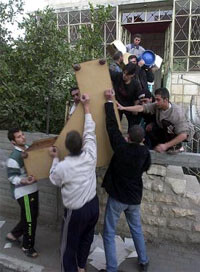
Above: “Palestinians remove belongings from a house in the southern West Bank town of Hebron after they were told by the Israeli army that it will be destroyed during the next few days, Sunday Nov. 17, 2002. Israeli troops massed in Hebron early Sunday, arresting Palestinians and restraining angry Jewish settlers after an ambush that killed 12 Israeli security forces ignited tensions, just as the United States was working to calm things down. (AP Photo/Nasser Shiyoukhi)” [original AP caption]
The radio also said that the prime minister told the officers that the army must create a situation that will ensure the safety of the Jews living in the divided city, and reduce to a minimum the presence of Palestinians in the area in which the settlers live.Note the line about removing Palestinians from the area “in which the settlers live”. That Palestinians also currently live there is apparently not considered important by the authors of this article.
The article reported that the head of the Kiryat Arba local council, Zvi Katzover, “called on the government to “clean up the area” between Kiryat Arba and the Tomb of the Patriarchs and to destroy the hundreds of Palestinian homes along this short stretch of road.”
“Senior officers,” the article continued, “said that, for now, they would destroy the homes of those who carried out the attack on Friday. Defense Minister Shaul Mofaz, though, has given orders to destroy homes along the Kiryat Arba-Hebron road if any link is found between their inhabitants and acts of terror.”
(Source: “PM calls for territorial continuity from Kiryat Arba to Hebron”, by Aluf Benn and Gideon Alon, Ha’aretz Correspondents and Ha’aretz Service, 17 November 2002.)
Of course there can be no open investigation of the roles of the perpetrators — who were apparently killed in combat after they had overwhelmed a superior Israeli force. Mofaz’s inclusion of the modifier “any link” to the general demolition order leaves the field wide open for destroying the homes of any distant relatives of the perpetrators or for their closeness to the attack. Indeed, the initial demolition of three homes in the vicinity of the attack has already been thinly justified and forgotten as the homes were places “from where the army said the troops had been fired at”.
Even today, some newspapers are still writing of an attack on “worshippers”.
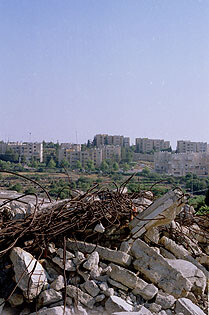
Above: A demolished Palestinian home in the foreground, the Jewish settlement of Kiryat Arba in the background. Encroachment and land confiscation are a daily struggle the magnitude of which only becomes apparent over time. Photo by Nigel Parry.
Andy Warhol’s famous assertion — in the future, everyone would experience 15 minutes of fame — has never looked as bleak in any other context. The world sits paralyzed in the face of a conveyor belt of misery parcelled out family by family nightly on our TV sets, while Israel and its most fanatical supporters wait ready to launch slanderous attacks and e-mail campaigns against any journalist brave enough to report the story straight.
One thing should break the paralysis in the face of the constantly changing geography on the ground — those paying attention should note that the bulldozers are moving in only one direction.
Related links:



